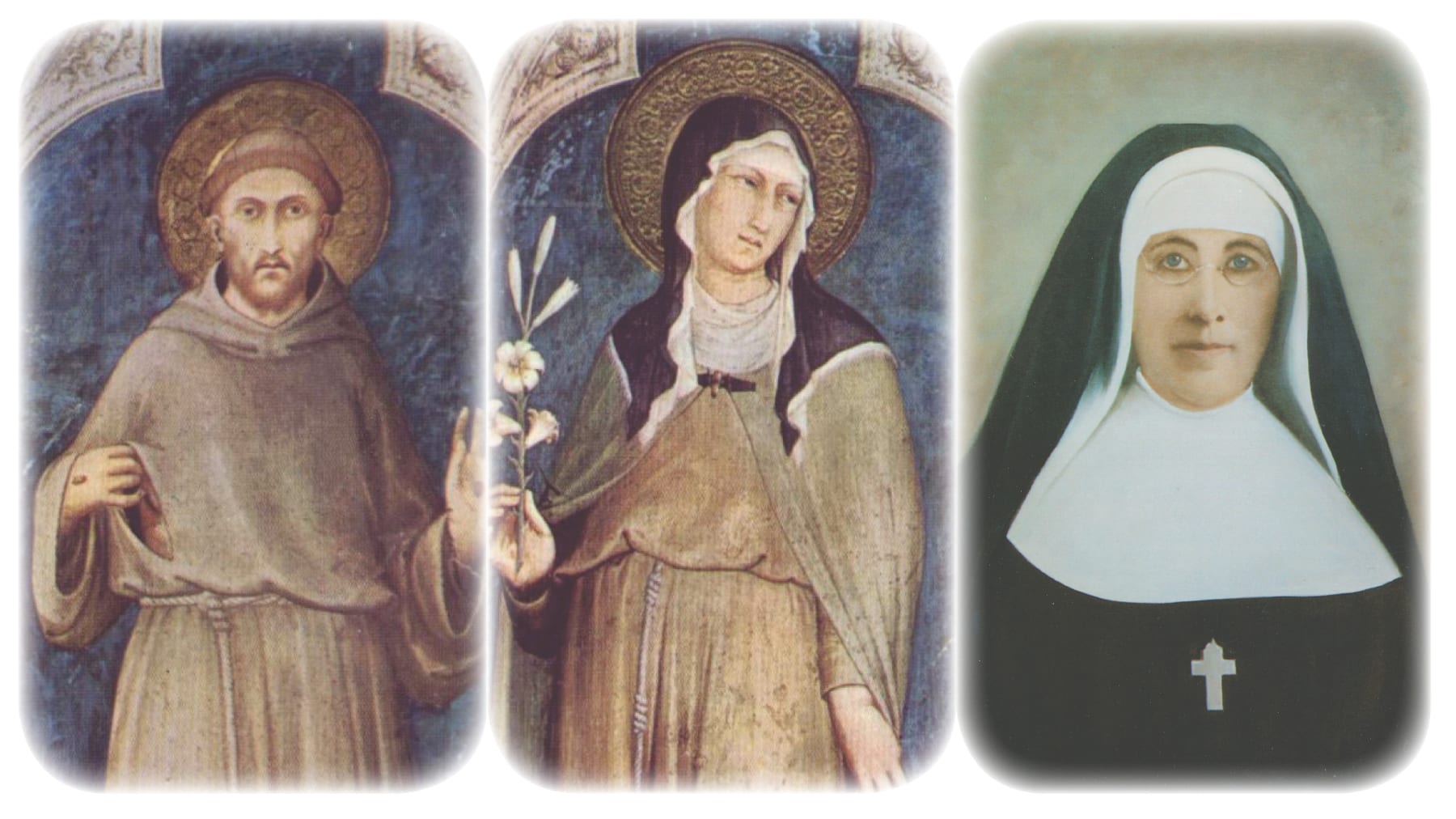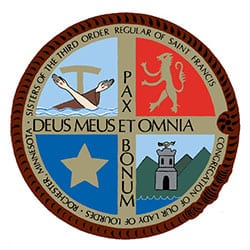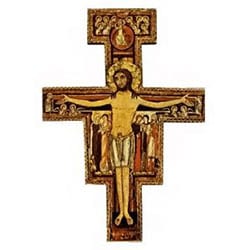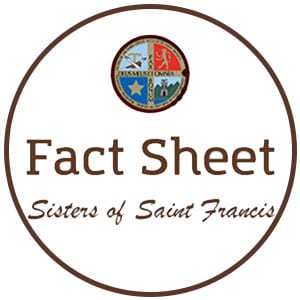
Our Mission
Led by the Holy Spirit to embrace the Gospel life of continual conversion, through prayer, community and service, in the tradition of Francis, Clare and Mother Alfred, we, Rochester Franciscan Sisters and Cojourners, commit ourselves to be a compassionate presence for peace in our world, striving for justice and reverence for all creation.
Rochester Franciscan Sisters are involved in many aspects of the community. They minister to prisoners, serve as therapists and administrators, artists and writers. They serve in parishes as pastoral ministers and on institutional and community boards.
Who Are Franciscans?
Franciscans are simply persons who follow the way of St. Francis and St. Clare — and thus of Jesus and the Gospel. The Rochester Franciscans live according to the Rule of St. Francis, a document based largely on Scripture. Most important for us today is bringing the spirit of St. Francis into the 21st Century. The essence of living our life is our relationship with Jesus Christ.

Our History
For over 140 years, the Sisters of Saint Francis of Rochester, Minnesota have pledged themselves to be faithful to the call of God and to each other.

- In 1877, Sister Mary Alfred Moes (shown right), along with her birth sister, Sister Barbara Moes, and 23 other Franciscan Sisters from Joliet, Illinois, came to Rochester, Minnesota, to establish a new community of Franciscan Sisters ready to serve as teachers.
- In 1883, Rochester was hit by a devastating tornado. The Franciscan Sisters provided care for the victims. Seeing the necessity for health care in the Rochester area, Mother Alfred persisted until Dr. William Worrall Mayo agreed to serve as director of a hospital to be built by the Sisters.
- Established in 1889, Saint Marys Hospital was on the cutting edge of health care. Today, Saint Marys is part of the Mayo Clinic, serving people from all over the world.
- The Sisters also continued their work in education, staffing parochial schools in Minnesota and beyond, while also establishing academies in Owatonna and Rochester. Their work included post-secondary education, and in 1894, they founded what would become the College of Saint Teresa in Winona, Minnesota.
- After the Second Vatican Council (1962-1965), many Sisters entered into areas of social service, spiritual care and went into service abroad. Others continued their ministries in health care and education.
- The value of the work of the Sisters’ teaching cannot be overestimated. The education they provided in these institutions made those they taught ready to pick up the reins and fill the needs of the parishes after Vatican II.
- The Sisters continue to be involved in the world, partnering with the poor and vulnerable, offering a voice on behalf of those who have none. They are diverse in their personalities and ministries, yet are united by faith in God, the Franciscan tradition, and the heritage of service passed on to them by their Foundress, Mother Alfred Moes.
Our Crest

The Crest of the Sisters of the Third Order Regular of Saint Francis, Congregation of Our Lady of Lourdes, Rochester, Minnesota, contains: upper left, Franciscan arms; lower left, North Star, sign of the state of Minnesota where the order was founded in 1877; upper right, Lion of Assisi, Italy, birthplace of the order; lower right, seal of Lourdes, France, where Mary appeared in 1858, as Our Lady of Lourdes, now patroness of the Congregation. The center cross is made by overlapping two Franciscan prayers, “Deus Meus et Omnia,” and “Pax et Bonum,” for seven centuries used by Franciscans as a greeting of peace and good. The whole is bounded by the cord with three knots signifying vows of poverty, chastity and obedience.
San Damiano Crucifix

When St. Francis was searching for his way in life and was in doubt and confusion, he came into the ruined church of San Damiano in Assisi, Italy. As he knelt before this crucifix praying, he heard Jesus calling to him, “Go, Francis, and rebuild my house, which as you see, is falling into ruin.” Francis left transformed with a mission and a vocation that was soon to be shared by thousands of brothers and sisters. He responded with his whole being. This crucifix now hangs in the church of St. Clare in Assisi.
TAU Cross

Over the years, the TAU cross has been worn on the forehead and has been placed on letters, doorways and walls. In ancient Palestine, the TAU referred to a stone marker to signify possession or belonging. Others used the TAU to symbolize the tree of life, regeneration, divine power and hidden wisdom. It is the last letter of the Hebrew alphabet and speaks of concepts of finality and forever. In an early Christian text, the Didache, the TAU means the “Word of God.”
For Francis, the TAU cross was the symbol of the internal conversion that must take place in order to truly follow in the footsteps of Christ. Francis often signed his letters with the TAU and made it a part of the community tradition among the brothers. Wherever it is used, the TAU signifies the will to personal conversion and the desire for reform in the Church. For Francis, it meant a sign of belonging to Christ, and it identifies its wearer as a wholly committed follower of the way of Jesus. Today, as shown in the example, it is a symbol of consecration for the followers of Christ in the charism/spirit of St. Francis.If you are in the market for clothes, our platform is your best choice! The largest shopping mall!
Receive our Magazine and Event Program Listing
To view our Fact Sheet, click on the image above.
For more information or questions, click the button below to reach Kathy Gatliff, Director of Communications and Public Relations.
To view our current issue, click on the image above. If you would like to view past publications, please click here.
To be added to our general mailing list to receive the interchange magazine and/or “The Essence of Assisi” program guide for our events at our Spirituality Center, please click on the button below.
Archives
The Archives Office at Assisi Heights is responsible for documenting the experience of the Sisters of Saint Francis in Rochester, Minnesota. Records and materials relevant to the origin, development, spirit and history are organized, preserved, protected, and when appropriate, made available. Since 1877, the Congregation has been involved in health care, education (elementary to college level), parish ministry, pastoral care, social justice and other ministries across the United States and in other countries; most notably, Colombia, Peru and Cambodia.
In addition, the Congregational Archives includes some material on the following, or can direct you to the appropriate contact person for: Saint Marys Hospital (now part of Mayo Clinic), founded in 1889; the College of Saint Teresa, Winona, Minnesota (sponsored by the Congregation from 1907-1989); Cojourners, lay associates affiliated with our Congregation.
The collection includes documents, photos and artifacts related to individual members, ministries, properties and governance from the time of the founding of the Congregation until the present day. Some materials are confidential. Contact Archivist for specifics, Monday thru Friday at: 507-282-7441, ext. 222, or click on the button below to email Sister Marisa McDonald.




